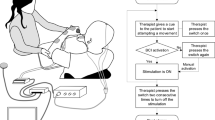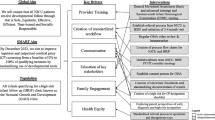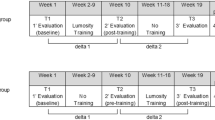ABSTRACT
Background
Children with unilateral cerebral palsy (UCP) learn not to use their affected upper limb, which is known as “developmental disregard”. Consequently, early intensive training could improve hand function, increasing spontaneous use for the first 2 years of life, where there is a great window for brain changes due to neural plasticity.
Objective
To study the effectiveness of home-based infant-intensive manual therapies in facilitating bimanual functional performance (BFP) compared to standard care in children with UCP aged 9–18 months.
Methods
A randomized controlled trial with single-blinded outcome assessment was conducted. Children were randomized into four groups: modified Constraint-Induced Movement Therapy for infants (infant-mCIMT), Bimanual Intensive Therapy for infants (InfantBIT), Hybrid Therapy, combining mCIMT and BIT, for infants (Infant-hybrid) and conventional therapy for children (Infant-standard-Therapy, control group-CG). Each early intensive protocol lasted 50 h and was applied throughout a 10-week period. The main outcomes were BFP, functional goals and parental satisfaction expectations regarding intensive manual therapy. Three measurements were performed (at Week 0, Week 10 and 6 months after treatment).
Results
Forty infants aged 12.38 months (chronological age) met the inclusion criteria. All groups except CG showed significant increases in BFP after infant intensive manual therapy and at 6 months compared with the baseline assessment (p < 0.01). The greatest increases in goal achievement and parent satisfaction occurred in the groups that had an mCIMT component.
Conclusions
Compared with standard therapy, early intensive manual therapies, i.e., infant-mCIMT, infant-BIT and infant-Hybrid therapy, resulted in greater increases in BFP and were maintained at the 6-month follow-up.
Clinical trial registration
ClinicalTrials.gov: NCT06191588.
Impact
-
Home-based early intensive manual therapies increase bimanual functional performance to a greater extent than conventional therapy.
-
Infant-Hybrid therapy may result in greater improvements in functional bimanual performance compared to Infant-mCIMT or Infant-BIT alone.
-
Higher therapy intensity and family involvement, particularly in home-based programs, are key factors for improving hand function compared to lower-dose, clinic-based usual care.
This is a preview of subscription content, access via your institution
Access options
Subscribe to this journal
Receive 14 print issues and online access
$259.00 per year
only $18.50 per issue
Buy this article
- Purchase on SpringerLink
- Instant access to full article PDF
Prices may be subject to local taxes which are calculated during checkout



Similar content being viewed by others
Data availability
The datasets generated during and/or analyzed during the current study are available from the corresponding author on reasonable request.
References
Rosenbaum, P. et al. A report: the definition and classification of cerebral palsy April 2006. Dev. Med. Child Neurol. 109, 8–14 (2007).
Johnson, A. Prevalence and characteristics of children with cerebral palsy in Europe. Dev. Med. Child Neurol. 44, 633–640 (2002).
Krumlinde-Sundholm, L. & Eliasson, A.-C. Comparing tests of tactile sensibility: aspects relevant to testing children with spastic hemiplegia. Dev. Med. Child Neurol. 44, 604–612 (2002).
Fedrizzi, E., Pagliano, E., Andreucci, E. & Oleari, G. Hand function in children with hemiplegic cerebral palsy: prospective follow-up and functional outcome in adolescence. Dev. Med. Child Neurol. 45, 85–91 (2003).
Novak, I. et al. Early, accurate diagnosis and early intervention in cerebral palsy: advances in diagnosis and treatment. JAMA Pediatr. 171, 897–907 (2017).
Basu, A. P. Early intervention after perinatal stroke: opportunities and challenges. Dev. Med. Child Neurol. 56, 516–521 (2014).
Hoare, B., Imms, C., Carey, L. & Wasiak, J. Constraint-induced movement therapy in the treatment of the upper limb in children with hemiplegic cerebral palsy: a Cochrane systematic review. Clin. Rehabil. 21, 675–685 (2007).
Cioni, G., Inguaggiato, E. & Sgandurra, G. Early intervention in neurodevelopmental disorders: underlying neural mechanisms. Dev. Med. Child Neurol. 58, 61–66 (2016).
Leech, K. A., Roemmich, R. T., Gordon, J., Reisman, D. S. & Cherry-Allen, K. M. Updates in motor learning: implications for physical therapist practice and education. Phys. Ther. 102, https://pubmed.ncbi.nlm.nih.gov/34718787/ (2022).
Martin, J. H., Friel, K. M., Salimi, I. & Chakrabarty, S. Activity- and use-dependent plasticity of the developing corticospinal system. Neurosci. Biobehav. Rev. 31, 1125–1135 (2007).
McKenzie, I. A. et al. Motor skill learning requires active central myelination. Science 346, 318–322 (2014).
Friel, K. M., Williams, P. T. J. A., Serradj, N., Chakrabarty, S. & Martin, J. H. Activity-based therapies for repair of the corticospinal system injured during development. Front. Neurol. 5, 1–11 (2014).
Ulrich, B. D. Opportunities for early intervention based on theory, basic neuroscience, and clinical science. Phys. Ther. 90, 1868–1880 (2010).
Jackman, M. et al. Interventions to improve physical function for children and young people with cerebral palsy: international clinical practice guideline. Dev. Med. Child Neurol. 64, 536–549 (2022).
Palomo-Carrión, R. et al. Early intervention in unilateral cerebral palsy: let’s listen to the families! What are their desires and perspectives? A preliminary family-researcher co-design study. Children 8, https://pubmed.ncbi.nlm.nih.gov/34572182/ (2021).
Akhbari Ziegler, S. & Hadders-Algra, M. Coaching approaches in early intervention and paediatric rehabilitation. Dev. Med. Child Neurol. 62, 569–574 (2020).
Chorna, O., Cioni, G. & Guzzetta, A. Principles of early intervention. Handb. Clin. Neurol. 174, 333–341 (2020).
Gordon, A. M., Schneider, J. A., Chinnan, A. & Charles, J. R. Efficacy of a hand-arm bimanual intensive therapy (HABIT) in children with hemiplegic cerebral palsy: a randomized control trial. Dev. Med. Child Neurol. 49, 830–838 (2007).
Boyd, R. N. et al. REACH: study protocol of a randomised trial of rehabilitation very early in congenital hemiplegia. BMJ Open 7, e017204 (2017).
Cohen-Holzer, M., Sorek, G., Kerem, J. & Katz-Leurer M. The impact of combined constraint-induced and bimanual arm training program on the perceived hand-use experience of children with unilateral cerebral palsy. Dev Neurorehabil. 20, 355–360 (2016).
Palomo-Carrión, R. et al. Combined intensive therapies at home in spastic unilateral cerebral palsy with high bimanual functional performance. What do they offer? A comparative randomised clinical trial. Ther. Adv. Chronic Dis. 12, https://pubmed.ncbi.nlm.nih.gov/34408823/ (2021).
Te Velde, A. et al. Neurodevelopmental therapy for cerebral palsy: a meta-analysis. Pediatrics 149, https://pubmed.ncbi.nlm.nih.gov/35607928/ (2022).
Geijen, M., Ketelaar, M., Sakzewski, L., Palisano, R. & Rameckers, E. Defining functional therapy in research involving children with cerebral palsy: a systematic review. Phys. Occup. Ther. Pediatr. 40, 231–246 (2020).
Blauw-Hospers, C. H. & Hadders-Algra, M. A systematic review of the effects of early intervention on motor development. Dev. Med. Child Neurol. 47, 421–432 (2005).
Blauw-Hospers, C. H., de Graaf-Peters, V. B., Dirks, T., Bos, A. F. & Hadders-Algra, M. Does early intervention in infants at high risk for a developmental motor disorder improve motor and cognitive development?. Neurosci. Biobehav. Rev. 31, 1201–1212 (2007).
Bobath, B. The very early treatment of cerebral palsy. Dev. Med. Child Neurol. 9, 373–390 (1967).
Zanon, M. A., Porfírio, G. J. M., Riera, R. & Martimbianco A. L. C. Neurodevelopmental treatment approaches for children with cerebral palsy. Cochrane Database Syst. Rev. 2015, CD011937 (2015).
Kaminker, M. K., Chiarello, L. A. & Smith, J. A. C. Decision making for physical therapy service delivery in schools: a nationwide analysis by geographic region. Pediatr. Phys. Ther. 18, 204–213 (2006).
Parkes, J., Hill, N., Dolk, H. & Donnelly, M. What influences physiotherapy use by children with cerebral palsy?. Child Care Health Dev. 30, 151–160 (2004).
Weindling, A. M., Cunningham, C. C., Glenn, S. M., Edwards, R. T. & Reeves, D. J. Additional therapy for young children with spastic cerebral palsy: a randomised controlled trial. Health Technol. Assess. 11, https://pubmed.ncbi.nlm.nih.gov/17462166/ (2007).
Roberts, C., Vogtle, L. & Stevenson, R. Effect of hemiplegia on skeletal maturation. J. Pediatr. 125, 824–828 (1994).
Schulz, K. F., Chalmers, I., Hayes, R. J. & Altman, D. G. Empirical evidence of bias. Dimensions of methodological quality associated with estimates of treatment effects in controlled trials. JAMA. 273, 408–412 (1995).
Ferre, C. L. & Gordon, A. M. Coaction of individual and environmental factors: a review of intensive therapy paradigms for children with unilateral spastic cerebral palsy. Dev. Med. Child Neurol. 59, 1139–1145 (2017).
Gordon, A. M. To constrain or not to constrain, and other stories of intensive upper extremity training for children with unilateral cerebral palsy. Dev. Med. Child Neurol. 53, 56–61 (2011).
Sakzewski, L., Provan, K., Ziviani, J. & Boyd, R. N. Comparison of dosage of intensive upper limb therapy for children with unilateral cerebral palsy: how big should the therapy pill be?. Res. Dev. Disabil. 37, 9–16 (2015).
Carton De Tournai, A. et al. Baby HABIT-ILE intervention: study protocol of a randomised controlled trial in infants aged 6–18 months with unilateral cerebral palsy. BMJ Open 14, e078383 (2024).
Novak, I. et al. State of the evidence traffic lights 2019: systematic review of interventions for preventing and treating children with cerebral palsy. Curr. Neurol. Neurosci. Rep. 20, https://pubmed.ncbi.nlm.nih.gov/32086598/ (2020).
Araneda, R. et al. Feasibility and effectiveness of HABIT-ILE in children aged 1 to 4 years with cerebral palsy: a pilot study. Ann. Phys. Rehabil. Med. 64, https://pubmed.ncbi.nlm.nih.gov/32320751/ (2021).
Schnackers, M. et al. Home-based bimanual training based on motor learning principles in children with unilateral cerebral palsy and their parents (the COAD-study): rationale and protocols. BMC Pediatr. 18, https://pubmed.ncbi.nlm.nih.gov/29669522/ (2018).
King, G. A. et al. An evaluation of functional, school-based therapy services for children with special needs. Phys. Occup. Ther. Pediatr. 19, 5–29 (2009).
Kiresuk, T. J., Smith, A. & Cardillo J. E. Goal Attainment Scaling: Applications, Theory, and Measurement (L. Erlbaum Associates, 1994)
Butler, C. & Darrah, J. Effects of neurodevelopmental treatment (NDT) for cerebral palsy: an AACPDM evidence report. Dev. Med. Child Neurol. 43, 778 (2001).
Harpster, K. et al. The methodological application of goal attainment scaling in pediatric rehabilitation research: a systematic review. Disabil. Rehabil. 41, 2855–2864 (2019).
Krasny-Pacini, A., Hiebel, J., Pauly, F., Godon, S. & Chevignard, M. Goal attainment scaling in rehabilitation: a literature-based update. Ann. Phys. Rehabil. Med. 56, 212–230 (2013).
Greaves, S., Imms, C., Dodd, K. & Krumlinde-Sundholm, L. Development of the mini-assisting hand assessment: evidence for content and internal scale validity. Dev. Med. Child Neurol. 55, 1030–1037 (2013).
Holmefur, M. M. & Krumlinde-Sundholm, L. Psychometric properties of a revised version of the Assisting Hand Assessment (Kids-AHA 5.0). Dev. Med. Child Neurol. 58, 618–624 (2016).
Holmefur, M., Aarts, P., Hoare, B. & Krumlinde-Sundholm, L. Test-retest and alternate forms reliability of the assisting hand assessment. J. Rehabil. Med. 41, 886–891 (2009).
Greaves, S., Holmfur, M., Bard-Pondarre, R. & Krumlinde-Sundholm, L. Linking the mini-assisting hand assessment and the assisting hand assessment in children with unilateral cerebral palsy. Dev. Med. Child Neurol. https://doi.org/10.1111/dmcn.16311 (2025).
Law, M. et al. Pilot testing of the canadian occupational performance measure: clinical and measurement issues. Can. J. Occup. Ther. 61, 191–197 (1994).
Law, M. et al. Canadian Occupational Performance Measure 5th edn (CAOT Publications ACE, 2014).
Jebb, A. T., Ng, V. & Tay, L. A review of key Likert scale development advances: 1995-2019. Front. Psychol. 12, https://pubmed.ncbi.nlm.nih.gov/34017283/ (2021).
Ferre, C. L. et al. Caregiver-directed home-based intensive bimanual training in young children with unilateral spastic cerebral palsy: a randomized trial. Dev. Med. Child Neurol. 59, 497–504 (2017).
Dirks, T. & Hadders-Algra, M. The role of the family in intervention of infants at high risk of cerebral palsy: a systematic analysis. Dev. Med. Child Neurol. 53, 62–67 (2011).
Sakzewski, L., Ziviani, J. & Boyd, R. N. Efficacy of upper limb therapies for unilateral cerebral palsy: a meta-analysis. Pediatrics 133, https://pubmed.ncbi.nlm.nih.gov/24366991/ (2014).
Hoare, B. J. et al. Constraint-induced movement therapy in children with unilateral cerebral palsy. Cochrane Database Syst. Rev. 4, https://pubmed.ncbi.nlm.nih.gov/30932166/ (2019).
Faccioli, S. et al. Evidence-based management and motor rehabilitation of cerebral palsy children and adolescents: a systematic review. Front. Neurol. 14, https://pubmed.ncbi.nlm.nih.gov/37305763/(2023).
Baker, A., Niles, N., Kysh, L. & Sargent, B. Effect of motor intervention for infants and toddlers with cerebral palsy: a systematic review and meta-analysis. Pediatr. Phys. Ther. 34, 297–307 (2022).
Tervahauta, M. H., Girolami, G. L. & Øberg, G. K. Efficacy of constraint-induced movement therapy compared with bimanual intensive training in children with unilateral cerebral palsy: a systematic review. Clin. Rehabil. 31, 1445–1456 (2017).
Araneda, R. et al. Brain activation changes following motor training in children with unilateral cerebral palsy: an fMRI study. Ann. Phys. Rehabil. Med. 64, https://pubmed.ncbi.nlm.nih.gov/33647530/ (2021).
Bleyenheuft, Y. et al. Motor skill training may restore impaired corticospinal tract fibers in children with cerebral palsy. Neurorehabil. Neural Repair 34, 533–546 (2020).
Araneda, R. et al. Changes induced by early hand-arm bimanual intensive therapy including lower extremities in young children with unilateral cerebral palsy: a randomized clinical trial. JAMA Pediatr. 178, 19–28 (2024).
Rostami, H. R. & Malamiri, R. A. Effect of treatment environment on modified constraint-induced movement therapy results in children with spastic hemiplegic cerebral palsy: a randomized controlled trial. Disabil. Rehabil. 34, 40–44 (2012).
Novak, I., Cusick, A. & Lannin, N. Occupational therapy home programs for cerebral palsy: double-blind, randomized, controlled trial. Pediatrics 124, https://pubmed.ncbi.nlm.nih.gov/19770175/ (2009).
Morgan, C. et al. Effectiveness of motor interventions in infants with cerebral palsy: a systematic review. Dev. Med. Child Neurol. 58, 900–909 (2016).
McKenzie, I. A. et al. Motor skill learning requires active central myelination. Science 346, 318 (2014).
Xiao, L. et al. Rapid production of new oligodendrocytes is required in the earliest stages of motor-skill learning. Nat. Neurosci. 19, 1210–1217 (2016).
Svensson, K., Eliasson, A. C., Sundelin, H. & Holmqvist, K. L. Parents in the driver’s seat—experiences of parent-delivered baby-mCIMT coached remotely. J. Clin. Med. 13, 4864 (2024).
Darrah, J. et al. Context therapy: a new intervention approach for children with cerebral palsy. Dev. Med. Child Neurol. 53, 615–620 (2011).
Löwing, K., Hamer, E. G., Bexelius, A. & Carlberg, E. B. Exploring the relationship of family goals and scores on standardized measures in children with cerebral palsy, using the ICF-CY. Dev. Neurorehabil. 14, 79–86 (2011).
Palomo-Carrión, R. et al. Modified constraint-induced movement therapy at home-is it possible? Families and children’s experience. Children 7, https://pubmed.ncbi.nlm.nih.gov/33266393/ (2020).
Taylor, E., Greaves, S. & Hoare, B. Barriers, facilitators, and a proposed model of care for implementation of upper limb distributed practice approaches for children with unilateral cerebral palsy. J. Clin. Med. 14, 924 (2025).
Bernabe-Zuñiga, J. E. et al. Early interventions with parental participation and their implications on the neurodevelopment of premature children: a systematic review and meta-analysis. Eur. Child Adolesc. Psychiatry. https://pubmed.ncbi.nlm.nih.gov/39028424/ (2024).
Dirks, T., Blauw-Hospers, C. H., Hulshof, L. J. & Hadders-Algra, M. Differences between the family-centered “COPCA” program and traditional infant physical therapy based on neurodevelopmental treatment principles. Phys. Ther. 91, 1303–1322 (2011).
Brandão, M. B. et al. Does dosage matter? A pilot study of hand-arm bimanual intensive training (HABIT) dose and dosing schedule in children with unilateral cerebral palsy. Phys. Occup. Ther. Pediatr. 38, 227–242 (2018).
Nordstrand, L., Holmefur, M., Kits, A. & Eliasson, A. C. Improvements in bimanual hand function after baby-CIMT in two-year old children with unilateral cerebral palsy: a retrospective study. Res. Dev. Disabil. 41–42, 86–93 (2015).
Chamudot, R., Parush, S., Rigbi, A., Horovitz, R. & Gross-Tsur, V. Effectiveness of modified constraint-induced movement therapy compared with bimanual therapy home programs for infants with hemiplegia: a randomized controlled trial. Am. J. Occup. Ther. 72, 7206205010p1–7206205010p9 (2018).
Boyd, R. N. et al. Randomized comparison trial of rehabilitation very early for infants with congenital hemiplegia. J. Pediatr. 277, 114381 (2025).
Sakzewski, L., Ziviani, J. & Boyd, R. Systematic review and meta-analysis of therapeutic management of upper-limb dysfunction in children with congenital hemiplegia. Pediatrics 123, https://pubmed.ncbi.nlm.nih.gov/19451190/ (2009).
Klepper, S. E., Clayton Krasinski, D., Gilb, M. C. & Khalil, N. Comparing unimanual and bimanual training in upper extremity function in children with unilateral cerebral palsy. Pediatr. Phys. Ther. 29, 288–306 (2017).
Yang, F. A. et al. Upper limb manual training for children with cerebral palsy: a systematic review and network meta-analysis of randomized controlled trials. Clin. Rehabil. 37, 516–533 (2023).
Rasmussen, P., Gillberg, C., Waldenström, E. & Svenson, B. Perceptual, motor and attentional deficits In seven-year-old children: neurological and neurodevelopmental aspects. Dev. Med. Child Neurol. 25, 315–333 (1983).
Araneda, R. et al. Protocol of changes induced by early Hand-Arm Bimanual Intensive Therapy Including Lower Extremities (e-HABIT-ILE) in pre-school children with bilateral cerebral palsy: a multisite randomized controlled trial. BMC Neurol. 20, https://pubmed.ncbi.nlm.nih.gov/32532249/ (2020).
Hoare, B. & Greaves, S. Unimanual versus bimanual therapy in children with unilateral cerebral palsy: Same, same, but different. J. Pediatr. Rehabil. Med. 10, 47–59 (2017).
Greaves, S. & Hoare, B. Upper limb therapy for infants and young children with unilateral cerebral palsy: a clinical framework. J. Clin. Med. 13, https://pubmed.ncbi.nlm.nih.gov/39598017/ (2024).
Morgan, C. et al. Early intervention for children aged 0 to 2 years with or at high risk of cerebral palsy: international clinical practice guideline based on systematic reviews. JAMA Pediatr. 175, 846–858 (2021).
Acknowledgements
The authors would like to thank all the families and infants for their collaboration in the study.
Author information
Authors and Affiliations
Contributions
Conceptualization: R.P.C., H.R.B., E.P.P. and C.L.R.; methodology: R.P.C., R.P.R.G., A.F.M., H.R.B. and E.P.P. writing—original draft preparation: R.P.C., R.P.R.G., A.F.M., H.R.B., C.L.R. and E.P.P.; writing—review and editing: R.P.C., R.P.R.G. and E.P.P. All the authors have read and agreed to the published version of the manuscript.
Corresponding author
Ethics declarations
Competing interests
The authors declare no competing interests.
Informed consent
The patient consent was required to all families who were included in the study.
Additional information
Publisher’s note Springer Nature remains neutral with regard to jurisdictional claims in published maps and institutional affiliations.
Supplementary information
Rights and permissions
Springer Nature or its licensor (e.g. a society or other partner) holds exclusive rights to this article under a publishing agreement with the author(s) or other rightsholder(s); author self-archiving of the accepted manuscript version of this article is solely governed by the terms of such publishing agreement and applicable law.
About this article
Cite this article
Palomo-Carrión, R., Pinero-Pinto, E., Lirio-Romero, C. et al. Home-based early intensive manual therapy in unilateral cerebral palsy under 2 years of age. Pediatr Res (2025). https://doi.org/10.1038/s41390-025-04306-4
Received:
Revised:
Accepted:
Published:
DOI: https://doi.org/10.1038/s41390-025-04306-4



